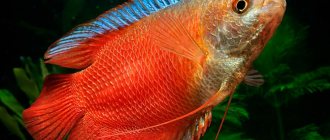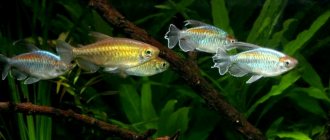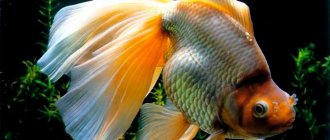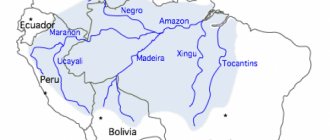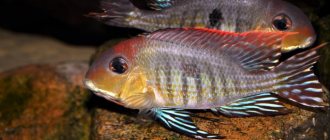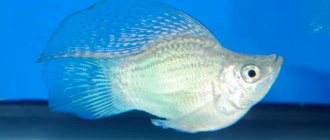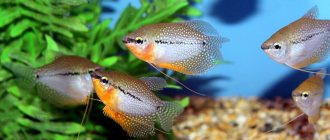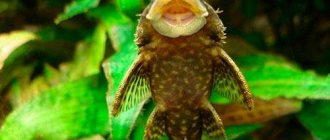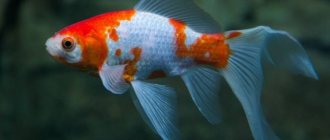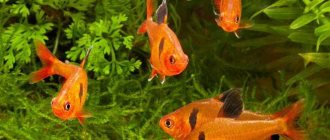Content
- 1 Description
- 2 Conditions of detention
- 3 Behavior and neighborhood
- 4 Food
- 5 Reproduction
- 6 Photos of minors
- 7 History of origin 7.1 Main groups of the genus Hyphessobrycon
- 7.2 Description of the genus group Hyphessobrycon
Crescent tetra: an unpretentious fish, therefore quite popular among aquarists.
- Other names: Serpas, Tetra crescent, Hephessobrycon minor, Black phantom (for black form)..
- Origin: tropical rivers and lakes of South America (Brazil, Paraguay, Guiana).
- Size: 4-5 cm.
- Temperature: 22-28 °C °C.
- Water parameters: pH water hardness up to 15 GH, acidity 6-7.2 pH.
- Lighting: diffused.
- Behavior: peaceful, gregarious.
- Additional information: prefer quiet, calm currents.
- Content difficulty: easy.
Description
Tetra minor, veil form
A very beautiful, bright fish that looks like a small flame. The body is elongated, slightly compressed from the sides. The color is bright red. There is a black spot on the head, behind the gills. A distinctive feature of the Minor is its dorsal fin. It has a quadrangular, elongated shape, is located almost vertically in relation to the body and is painted black. They often have a white edging along the edge of the fin. The anal and caudal fins are red. There is an elongated, veil-shaped fin. The eyes are expressive, black. In an aquarium they grow no more than 4-5 cm.
Minor - small flame!
Compatibility
When keeping minors in a community aquarium, it should be taken into account that serpas is a playful fish that can be aggressive towards smaller residents or veil phenotypes, so you should not stock these types of fish. The minor fish demonstrates good compatibility with large and rapid phenotypes, for example:
- Ancistrus;
- zebrafish;
- neons;
- barbs.
You should also know that the compatibility of the serpas with other fish depends on the number of representatives of the minors in the general aquarium. Minors prefer gregarious living, otherwise the male will engage in skirmishes and battles with other residents.
Conditions of detention
Minor is an unpretentious fish, which is why it is quite popular among aquarists. It can be recommended to a novice aquarist. This fish is schooling, so it is recommended to keep 5-6 individuals. Each fish requires at least 10 liters of water. That is, ideally, an aquarium of 60 liters or more is suitable for a school of fish. As a primer, you can use, for example, sand or fine gravel of dark colors to highlight the bright cutting. The aquarium can be decorated with various shelters, such as broken shards, grottoes, driftwood, caves, stones. You can plant any plants in an aquarium; the fish is indifferent to them and will not dig them up or tear them off and eat the leaves. It is recommended to arrange thickets, for example, plant Java moss, elodea, and nubias along the back wall of the aquarium, but be sure to leave enough free space for swimming. Minors prefer the middle and lower layers of water. Since fish prefer diffused, dim light, it is recommended to place floating plants on the surface. Filtration and aeration are mandatory. Water changes must be made at least once a week in a volume of up to 20% of the total volume of the aquarium.
Floating plants on the surface of the water are a must to diffuse bright light!
Where is the best place to place an aquarium in the house?
Placing an aquarium in a house often becomes a problem: you want it not to become a nuisance that takes up space, but to be conveniently located and serve as a decorative element; in addition, its location should be convenient for its inhabitants, at least in terms of lighting.
The hallway is not the best option; as a rule, there is not enough light in it, in addition, experts do not recommend installing an aquarium in drafts.
The kitchen is also not a suitable option: there is a stove, a refrigerator, and other electrical appliances, with the exception of the kitchens of large apartments or private houses, which are spacious and have a convenient layout.
An aquarium in the bedroom is an additional way of relaxation after a hard day, even a kind of romantic entourage. For the bedroom, you should choose models with silent filters.
The ideal option would be the living room. Here, a large aquarium can serve as a dividing barrier between certain zones; it can be installed in a niche and beautifully decorated.
Typically, the living room is the most spacious room, which means it has enough space and light. You don't have to install additional lighting.
Learn how to care for hornwort in an aquarium.
Behavior and neighborhood
Minor is a peaceful fish if kept in a school and its neighbors are not inferior to them in size and activity. When alone, he can be aggressive. You should choose the same active, playful and fast fish as neighbors, for example, zebrafish, black neons, barbs, ancistrus. Smaller neighbors or those who swim slowly or have veil fins are absolutely not suitable for the minor. He will bite his fins, chase him around the aquarium and eventually kill his neighbor. Therefore, goldfish, angelfish or bettas are strictly prohibited.
Diseases and their treatment
Minor (blood tetra) suffers from common diseases for all aquarium fish. There are no differences in symptoms, course of diseases and treatment.
The most common ailments:
- poisoning with nitrogenous compounds;
- white-skinned;
- fin rot;
- ichthyophriasis;
- asphyxia.
It is advisable to view photos of the symptoms of all diseases in order to know when to sound the alarm. Contagious diseases must be treated with the use of bactericidal and fungicidal drugs. Self-treatment is strictly prohibited; consultation with a veterinarian is required.
General disease prevention measures include:
- Purchase fish and equipment only from trusted sellers.
- Maintaining all water parameters.
- Adequate nutrition and proper feeding regimen.
- Regular cleaning of the aquarium.
- Visually inspect pets for signs of any disease.
If you follow these simple rules, you don’t have to worry about the minor’s well-being.
Nutrition
Minor is absolutely unpretentious in food. The only thing worth remembering is that this fish is small and so is its mouth, so the food must be given in small fractions or pre-chopped. In food you can use crustaceans, bloodworms, tubifex, fruit flies. Of the dry ones, you should give preference to flakes or granules, but you should not get carried away with them. In order for the diet to be balanced, the fish can and should be periodically fed with plant foods, such as spinach, dandelions, and redwood. Vegetables can be fed with zucchini, cabbage and cucumber, previously blanched. Minor does not feel full, so it is not recommended to overfeed the fish. It will be enough to feed it once a day with a small portion, so that the fish eat it in a few minutes. All excess food must be removed from the aquarium using a siphon to prevent imbalance in the aquarium.
What to feed
The choice of food for adults is wide; they consume live, artificial and frozen food, the only thing to consider is that the minor has a small mouth, so the food should not be large in size.
Fish will not refuse dry flakes in granules, insects, bloodworms, enchytraeus, crustaceans.
The fry are fed with ciliates, rotifers, and nauplii.
Did you know? The first glass aquarium was made by the English scientist Nathaniel Ward in 1841. The container had a volume of one hundred liters; it contained plants and fish living in cold waters.
Reproduction
Breeding a Minor is not difficult. It is enough to create the conditions necessary for spawning. Reproductive age is reached at 9-11 months. It is quite difficult to distinguish males from females and it is impossible to do this at a young age. The differences are clearly visible during spawning or before spawning. Males are brighter than females, while females, in turn, have a more rounded abdomen. For the spawning tank, it is recommended to take a separate aquarium of 10-20 liters. A separate mesh must be placed on the bottom to prevent the parents from eating the eggs. Soil is completely optional, but plants are possible. Small-leaved, long-stemmed varieties are recommended, but Java moss or fern can also be used. Lighting should be dim and diffused. Before spawning, the fish are fed generously. The temperature in the spawning tank is kept in the range of 25-27 degrees and a couple, or preferably 3-4 fish, are released. The female lays 200-300 eggs. After spawning, the parents are placed back in the aquarium. The fry appear after 1-2 days and begin to swim at 4-5 days. The fry need to be fed generously - 5-6 times a day. They grow quite quickly and, unlike adults, do not suffer from obesity or overeating. Cyclops nauplii, daphnia, and rotifers can be used as food.
Breeding
Reproduction of Minor does not require special skills; it is enough to create the necessary conditions in the spawning aquarium. For breeding you will need an equal number of females and males.
The tank is used in small sizes, with minimal lighting. The bottom is lined with plant leaves or moss.
Water must meet the following indicators:
| Rigidity | Acidity | Temperature |
| 6-8°dH | 6.0 pH | +27 °С |
Future parents are fed abundantly with a variety of live foods. When the males reach maximum brightness and the abdomens of the females are noticeably rounded, they can be transplanted into the spawning tank.
It is better to do this in the evening, since the process begins in the morning.
The swept and fertilized eggs fall onto the leaves of the plants. Adult fish are returned to the main aquarium, and the tank with eggs is shaded; light can destroy the clutch. The incubation period lasts two days, then the first fry appear. Initially, they feed on the yolk sac; as soon as the ability to move independently appears, the juveniles begin to be fed. In the first feeding they give ciliates and egg yolk, as they grow older they transfer to artemia nauplii and gradually to adult foods.
Origin story
It is well known that this genus was isolated in 1908 by Durbin.
Some sources give a literal translation of the word "hifessobrikon" as "small brikon" (however, it should be noted that for the Latin language its constituent syllables are rare enough to confirm this). A valid definition of the genus was made by Eigemann (1918, 1921). Today, about 110 species of fish of the genus Hyphessobrycon
, belonging to the subfamily
Tetragonopterinae
, which includes most of the charicinids kept in decorative aquariums.
The genus closest to it is Hemigrammus, Gill 1858
with which they are literally located together on the same taxonomic “fork” [1]. The difference is determined mainly by differences in the structure of the caudal fin. Also, the genus Paracheirodon is very close to it, and the debate about its isolation in scientific circles has not yet subsided, for which there are serious reasons. Over time, in the genus Hifessobricon itself, a division of species into 5 groups was identified (Hoedeman 1954, Gery 1977, G. Shterba), which is quite arbitrary and now no longer covers all species, but still allows us to at least approximately see the overall picture. In turn, these groups can be formed into two main supergroups based on characteristics characterizing body shape and color.
Main groups of the genus Hyphessobrycon
| Generalization of groups | supergroup I | supergroup II | |||
| Existing groups | Bentosi | Callistus | Bifasciatus | Heterorhabdus | Metae |
| Images of iconic species: | [2] | [3] | [4] | ||
| Body Shape: | tall, diamond-shaped; enlarged dorsal muscle | elongated, “torpedo-shaped” | |||
| Body color: | weakly expressed, or with large but barely noticeable blurry spots | with a certain toning from yellowish to intense red; with one dark spot on the anterior half of the body, except for H.georgettae | with two dark comma-shaped spots on the anterior half of the body | with two horizontal lines from head to tail: pearlescent (can be of different colors) and intense black underneath | the same, but the black line downwards, blurring, becomes a spot |
| Kinds: | N. bentosi N. rosaceus N. erythrostigma H. socolofi N. robertsi | H. eques H. georgettae H. haraldschultzi H. minor N. takesi | H.bifasciatus H.flammeus H.griemi H.equadoriensis | N. agulha H. scholzei H. stegemanni H. heterorhabdus H. vilmae H. herbertaxelrodi | N. metae H. peruvianus N. loretoensis |
Habitat in nature
The minora is otherwise called the long-finned sickle, veiled, bloody or red tetra. The homeland of this fish is the lakes of South America. Most often found in Paraguay, Brazil and Guiana. The species was first described in 1882. Minor belongs to the Kharatsinov family, which for a long time was considered the least studied, so disputes about the scientist who discovered the serpas and the year of the first publication are still ongoing.
The fish lived for a long time in isolation in the small backwaters that form the Amazon and Guapore rivers. Fish are more adapted to life in stagnant water; even a slight current with prolonged exposure causes stress in them.
Different wild populations of the same species have striking differences in bone strength and structure. Thus, only in the twenties of the last century was a reservoir with endemic sickles that lived in French Guiana discovered.
